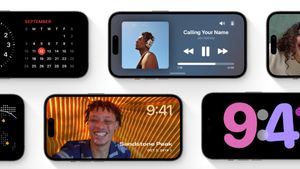
JAKARTA - It was recently reported that experts have begun to imagine how future smartphones will develop using artificial intelligence (AI). Using AI imaging, Mobiles.co.uk has predicted five different ways in which smartphones may develop in the future.
Even though the iPhone 15 has just been released, experts have produced an overview of more innovative devices. From flexural phones to self-improving devices, maybe one day your iPhone will look and feel very different.
Using a combination of Midjourney, Dalle3, and Adobe Firefly AI tools, experts have been able to create images of how your phone might look in the future. This prediction is based on various features and continuous changes that are considered possible.
관련 항목:
Lentur Materials: The futuristic technology that is already under development is a flexural phone. Folding phones such as the Motorola Razr Plus already use some bending materials to open and close large touchscreens.
According to AI, future phones will be completely flexible to 'create your self-flexible phone'. Sustainability consultant Jennifer von Walderdorff said that this technology may soon come involving flexible use of organic light-emitting diodes.
Recently, Motorola introduced the concept of a foldable phone that can be stretched around the wrist. This is dubbed the first smartphone in the world to use, with a 6.9-inch full HD+ phone screen that appears conventional.
Solar Power Filling: Experts predict that in the future, cell phone charging will no longer use conventional methods. Solar power is an option that is superior.
Walderdorff said that innovation in solar charging was evident by the presence of a portable solar charger device to support the device for several days away from the socket.
Although there is no integrated solar panels on mobile phones as implied by experts and AI, Walderdorff believes that demand for renewable energy will drive the development of solar technology.
Self-Repair Technology: As an alternative to expensive improvements due to physical damage, experts say that future phones may be able to improve themselves. While it sounds like science fiction technology, researchers from Stanford University recently developed synthetic skins that can heal themselves using heat and magnets.
Sustainable Materials: Given the huge impact of mobile phone on world resources, experts believe that future phones will switch to more sustainable materials. By developing materials with better environmental performance, it can reduce industry dependence on unrenewable resources.
The increase in Genggaman: Experts believe that future phones should be easier to hold to reduce the risk of falling. Using AI, experts envision that one day phones may have a'snake skin-style ship' for a better grip and durability.
The question now is, will these ideas be the future of the phone or will it only stop at the image table? Only time will give the answer.
The English, Chinese, Japanese, Arabic, and French versions are automatically generated by the AI. So there may still be inaccuracies in translating, please always see Indonesian as our main language. (system supported by DigitalSiber.id)

















